The fall and winter rains have pushed our planting plans off schedule in recent weeks, but with the rain…we have the return of ‘Mushroom Mondays’!
Last winter I looked high and low for any evidence of this fungus, but by the time I finally found one, the dry season was upon us, and the only specimens I found were already dessicated.
This year I’ve kept my eyes open since the rains returned, and now these tiny fungi seem to be growing everywhere.
Crucibulum laeve is in the Nidulariacaea family of fungi, and the most common species of bird’s nest fungus likely to be encountered in the San Francisco and Monterey Bay area.
Crucibulum are saprobic fungi, obtaining all their required nutrients from decaying organic matter. Typically found on woody debris, they may rarely be found on larger logs.
The overall characteristics of this species make it clear how the common name ‘Birds Nest Fungus’ came about. The main cup-shaped fruiting body, called the peridia, resembles a small nest, and toward the final stage of development, these ‘nests’ can be seen with spore-filled ‘eggs’.
There are three distinct stages of growth of this fungus. Being able to recognize each stage of growth makes it easier to identify this species throughout the winter months. I’ve been watching a colony on some woody debris for the past few weeks, but on first encounter, it wasn’t obvious to my then untrained eye that they would eventually develop into the classic birds nest. After observing this species throughout its life-cycle this year, I feel confident I could now recognize it anywhere.
The fruiting bodies of this species are initially yellowish, and grow 5-8 mm high, and up to 15 mm across. They have a pillow to round shape at first, and appear to be capped with an ochraceous lid, called an epiphragm.
In the second, more mature phase, the fruiting bodies become more cylindrical with a narrowed base, and the thickness of the epiphragm decreases and turns a pale buff color.
As the fungus matures further, the lid gradually disappears, revealing the tiny 1-2 mm white, to pale grey, ‘eggs’, called peridioles. It’s the appearance of this final stage that gives this species the moniker bird’s nest fungus.
A distinguishing characteristic of species within the Crucibulum genus is that the peridioles are attached to the interior of the ‘nest’, called the endoperidium, by a simple funiculus, an adhesive cord of hyphae, which the ‘eggs’ use to attach themselves to woody debris.
The cup-shaped nests act as splash cups, facilitating the dispersal of the eggs. Once the lid has disappeared, when a raindrop strikes the cup at the appropriate angle, the eggs are projected out of the nest, stretching the hyphae until the egg breaks free of the cup. The cord remains attached to one end of the egg, and the free sticky ends of the cord hold the egg to the leaf or stick where it becomes attached, and starts the cycle over again.
Species in the Nidulariaceae family, including Crucibulum, are considered inedible, not due to toxicity per se, but because they are not sufficiently fleshy to be culinarily useful.
Regardless, this is a common and rather charming species of fungus to kick off this season’s Mushroom Monday posts. (For all of our fungus posts to date, see our Fungi blog category). I expect our Mushroom Monday posts won’t be as regular this year, but that depends on how many new species we encounter compared to last year…we’ll have to wait and see what the rest of winter brings!

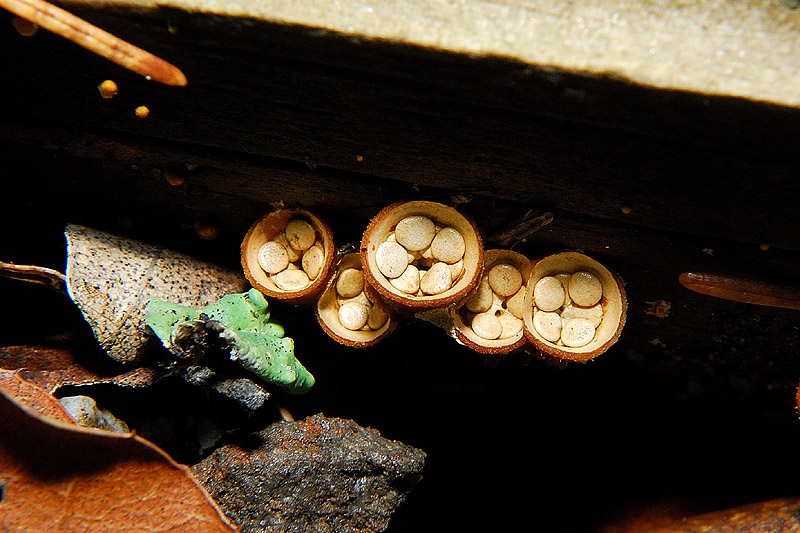
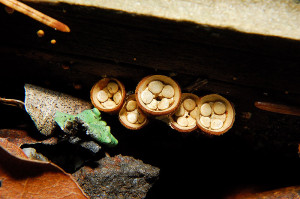

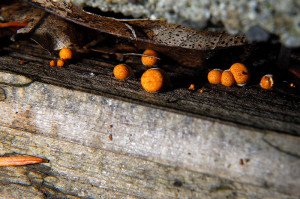
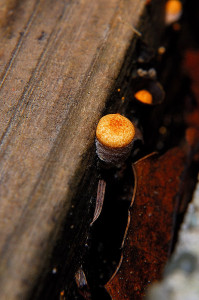
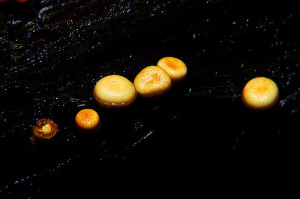
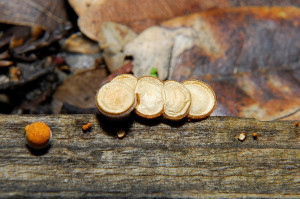
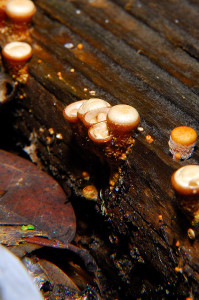
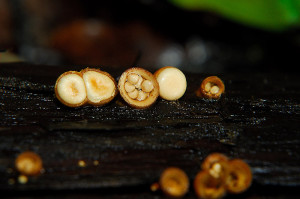
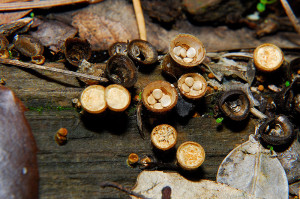
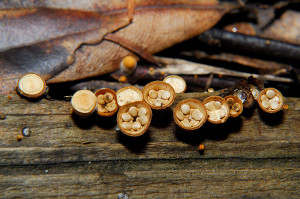
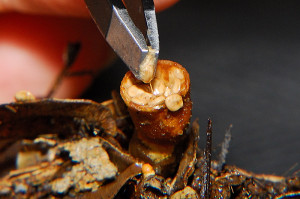
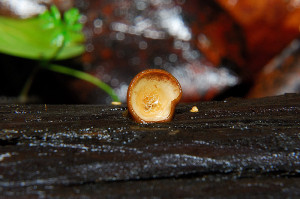







Ooh! I am very excited about Mushroom Mondays! Your bird’s nest photos are outstanding — I hadn’t paid attention to them pre-nest before but now that I’ve seen your pictures I realize that they’re familiar to me. Typically, I notice them all over our mulch after they’ve made their eggs.
You do know that you have far too much knowledge of mushrooms, right? (Just kidding….I find them fascinating myself.) That is a beautiful and interesting species. Too bad its inedible, as it looks like a delicious sweet confection.
Actually, my knowledge about fungi is better than it was, but still very amateur! Hoping to expand my knowledge a little more this weekend though at our annual Fungus Fair in town! 🙂
How neat! I can’t wait to see more fungi!
What fun Mondays are going to be around here~I’m going to get my Mycellium Running book out and bone up on terms! gail
These are really pretty and interesting mushrooms. I am glad you are going to do more and I am going to have to pay better attention when I am out walking in the woods.
Great shots and detailing of this fascinating little mushroom. I love the latin name, which I assume refers to its cup shape?
Exactly, the genus name Crucibulum refers to the crucible or cup-shape of the fruiting bodies. I love Latin, although I hated it when I studied it in high school, but I find it endlessly useful these days!
Great post Clare. What phenomenal stages, especially the formation of the “eggs”. Mushrooms are so beautiful, even exquisite in their form.
We have lots of different ones around due to the rain, but regretfully I don’t know my fungus. 😉
I hope you have a healthy and happy New Year and wish you many blessings. Thank you for being a part of my 2010.
Very cool! I’ll have to look out for these, usually my focus is on chantrelles (which I find very rarely), maybe I need to expand my horizon…
Wow. Amazing photos of an exceedingly charming life form. =) So, what are you planning to plant this time of year? Inland CA is COLD right now (28dF right now), so my planting plans are quite a ways off–therefore I’m curious about what y’all do this time of year.
Was a balmy 31F here this morning 😉 Actually, I can still sneak some of my California natives in the ground through the end of January…once I can stand on the slope to dig holes without sliding into the creek! It’s also prime bare root fruit season here. Most nurseries along the coast are just getting their stock of fruit trees, and canes, like raspberries and olallieberries this week. Picked up a native Huckleberry, some cane fruits, and more fruit trees for the orchard, that all need to be planted out. Also time to get seeds together to start indoors beginning in a couple of weeks. It’s a busy time of year! Good news is…finally…the sun is actually shining!
Mushrooms/fungi are on my life list of things to fully explore. I will get there someday. Meanwhile I will look for these cute little guys and look forward to more education from you.
Once I started paying attention to fungi here, I started to find them rather fascinating. It’s much more fun now that I can recognize some and know what there are, instead of ‘oh, look at the pretty mushroom’. Trouble is, for every one I can identify, there are a dozen or more I can’t! For some of them, it’s really tricky, and I don’t have all the tools here I’d need to make a conclusive ID. Still fun to try though!
So interesting! This is the one that you identified for me last year. I haven’t seen any of them this year…but I’ll keep looking.
Fascinating. I haven’t seen those before. The eggs bouncing out of the nest is yet another example of nature’s weird and wonderful means of propagation !